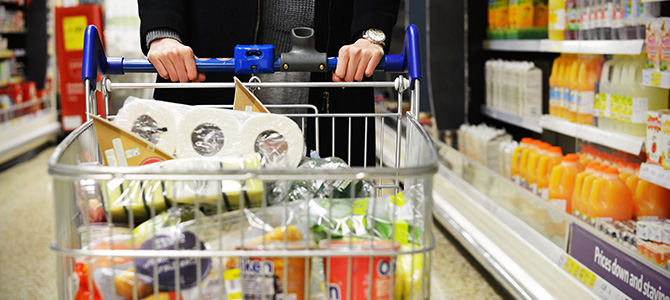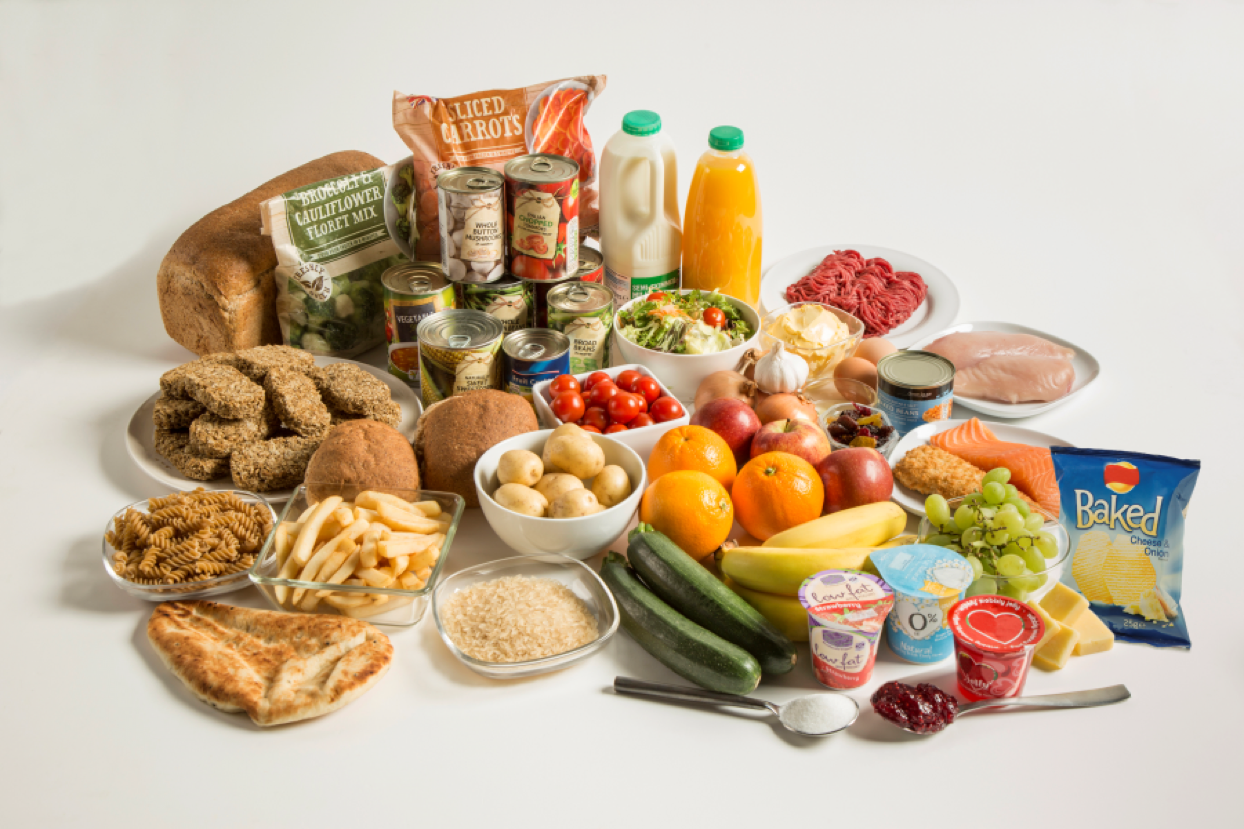Healthy Eating Tutorial
Introduction

There are many things which can help us make healthier choices when we are buying food and drink. whether we are doing our shopping or eating out. This module focuses on the help available to achieve a healthy diet, including nutrition labels and schemes designed to help retailers and caterers make their offerings healthier.
By the end of this module you will:
- Be able to broadly translate the Eatwell Guide messages into a week’s healthy food and drink intake.
- Know what support is available to help you make good choices about food and drink.
Shopping

This photo demonstrates an example of a week’s worth of food shopping for one person, and shows the balance of different foods selected using the Eatwell Guide as reference. The quantities shown are based on the calorie requirements for an average woman (2,000 calories).
Around 20% of the calories and fat, and over half the sugar we eat comes from discretionary foods and drinks, such as confectionery, cakes, biscuits, pastries, savoury snacks and sugary drinks. However, these are items we don’t need for a healthy diet.
Tips to follow when shopping for food and drink:
- Base meals around starchy carbohydrate foods e.g. wholegrain cereal for breakfast, a sandwich with wholegrain bread for lunch, and potatoes, pasta or rice for dinner. These foods should make up approximately one third of a weekly food shop.
- One third of a food shop for the week should consist of fruits and vegetables. These can be fresh, frozen, tinned or dried.
- Buy two portions of fish for the week, including one oily fish.
- Choose leaner cuts of meat e.g. chicken, turkey or lean mince.
- Opt for low-fat and low-sugar dairy or dairy alternatives, and unsaturated oils and spreads.
- Limit buying discretionary food and drinks.
Eat Well, Your Way
Food Standards Scotland has developed Eat Well, Your Way to help people in Scotland make healthier food and drink choices when planning and shopping, preparing food and eating out. Choosing healthier options can be a challenge, with busy schedules, budgets and other life pressures. Eat Well, Your Way is here to help with making small, manageable changes, in ways that suit.
Eatwell Everyday
Eatwell Everyday demonstrates how to use the Eatwell Guide to bring its recommendations together for a healthy balanced diet, including two weekly meal plan examples. Each meal plan contains tips and advice to help create a healthy balanced diet, supporting people in making positive long-term changes. Eatwell Everyday also includes a shopping list for a family of four, providing ingredients to make the suggested recipes given in the meal plan examples.
Analysis by the Carbon Trust in 2016 found that following the Eatwell Guide has a 32% lower environmental footprint than our current diet in the UK.
Schemes to help support healthier choices when shopping for food and drink
Some local retailers are part of the Scottish Grocers Federation Healthy Living Programme, which aims to support stores to highlight, increase and promote sales of healthier products - mainly fruits and vegetables. Also included in the scheme are products such as water, milk, sugar-free drinks, healthier cereals, rice and pasta.
Understanding food labels
Nutrition labels provide information on the nutrient content of foods and drinks.
There are two types of nutrition labels:
- Back or side of pack
- Front of pack
Back or side of pack nutrition labels
By law, most pre-packed foods and drinks in the UK must provide nutrition information on the back or side of food packs. These labels should display the energy, total fat, saturated fat, carbohydrate, total sugars, protein and salt content per 100g/ml of the product.

Front of pack nutrition labels

Most pre-packaged foods also display nutrition information on the front of pack, though this is not mandatory and is done on a voluntary basis.
These labels show:
- The portion size. These are suggestions and may not be the same as the amount actually consumed
- The amount of energy, fat, saturated fat, sugars and salt per portion
- Energy per 100g of the product
- The amount that a portion contributes to your daily diet is given as a percentage of the reference intake
Front of pack nutrition labels are colour coded and can help people see at a glance whether a product is high (red), medium (amber) or low (green) in fats, sugar and salt. This makes it easier to identify and choose healthier versions of similar products (e.g. choosing between ready meals). Many of the foods with front of pack labelling will have a mixture of red, amber and greens. So, when choosing between similar products, it is healthier to go for more greens and ambers, and fewer reds.
Eating out

More and more of us are eating out and on the go. This includes:
- Picking up a snack from a convenience shop
- Buying a drink from a vending machine
- Buying a sandwich for lunch
- Eating in the work canteen
- Having dinner in a restaurant
- Ordering a takeaway
On average, people in Scotland eat out and on the go about 4 times a week. Many of the popular choices when eating out or ordering in are also high in energy (calories), fats, sugar and salt including, chips, burgers, cakes, biscuits and pastries and sugary drinks.
Tips to follow when eating out or ordering in:
- Calorie labelling: some outlets provide calorie information on their menus or menu boards, either in shops or online. Compare the calorie content of meals with how many calories are needed each day (around 2,000 for the average woman, and 2,500 for the average male).
- Nutrition labels: nutrition information on the front and back of pack of pre-packaged foods can help identify healthier choices.
Summary
To help achieve a healthy diet:
- Weekly shopping should aim to reflect the balance and types of foods in the Eatwell Guide.
- Nutrition information displayed on the front and back of pack can help to identify healthier choices.
- Calorie and nutrition information on menus, menu boards or online can help to choose healthier options when eating out.
- Look out for the Scottish Grocer’s Federation Healthy Living Programme.
Module 3 quiz
Answer the questions below to see what you've learned and to complete module 3.
-
Which of the following statements is true?
Choose 1 answer
CorrectIncorrect -
Which of the following statements is true?
Choose 1 answer
CorrectIncorrect -
In the UK, most pre-packed foods and drinks in the UK must provide nutrition information on the back or side of food packs.
Choose 1 answer
CorrectIncorrect
You completed Module 3 – complete all modules to progress.
Back to overview